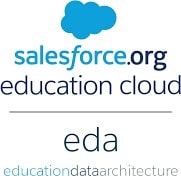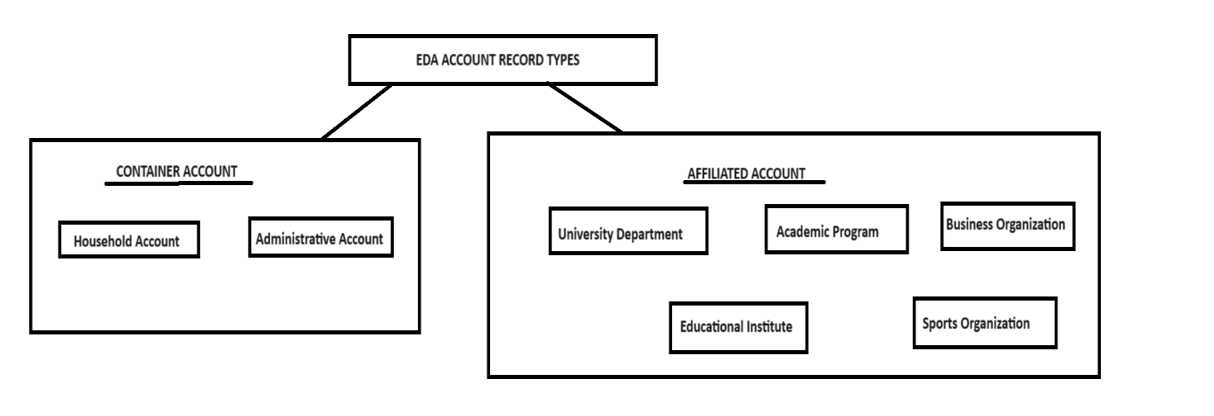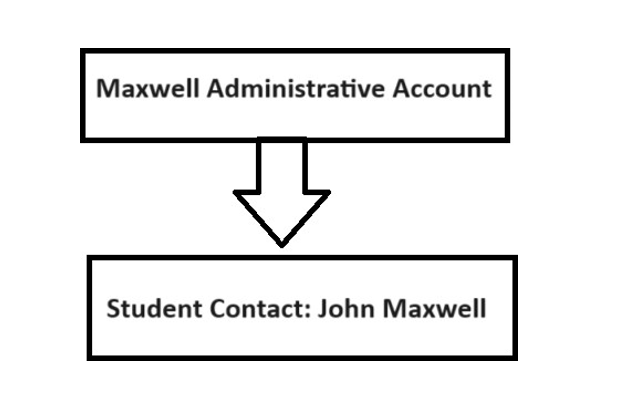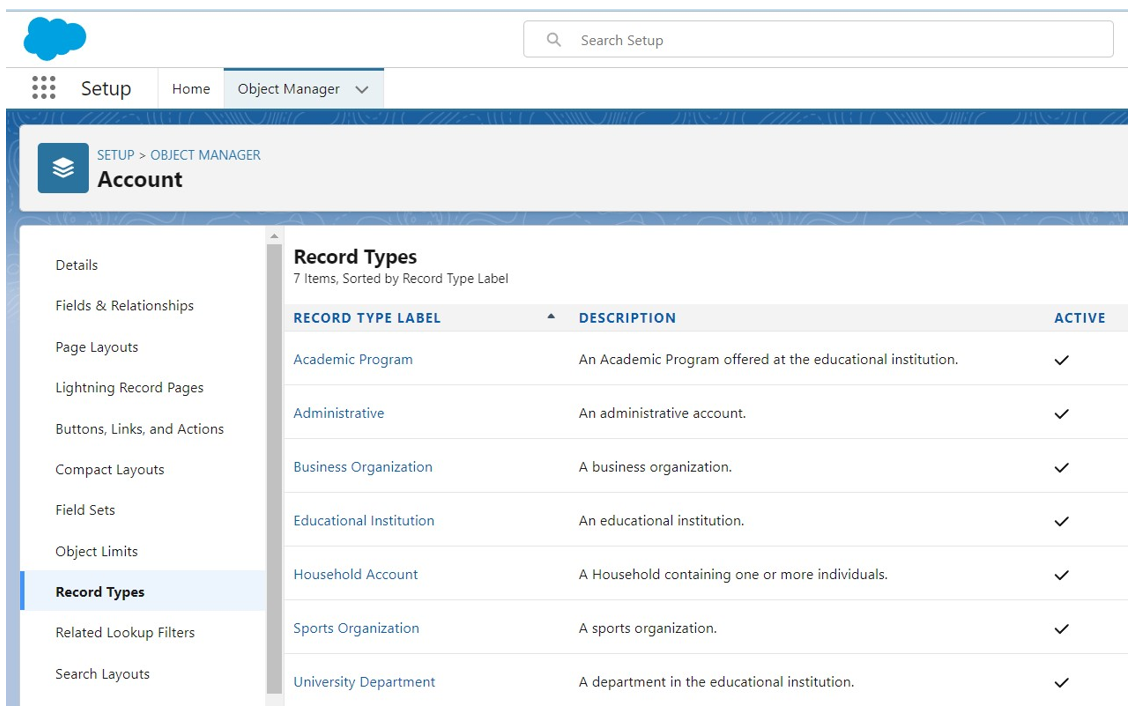Tailoring Education: Decoding Salesforce EDA Account Record Types for Institutions
Author
The Education Data Architecture (EDA) serves as a meticulously designed data framework tailored specifically for educational institutions. Developed through collaboration with Salesforce.org partners and customers, EDA delivers pre-built functionality to streamline data organization within Salesforce. It acts as a virtual pantry stocked with a variety of tools, connecting educational institutions of all sizes with students, alumni, parents, and faculty in diverse ways. Picture EDA as a well-organized pantry, ensuring that all your data ingredients are neatly arranged for easy accessibility—making it a must-have resource.
Before the introduction of EDA, education administrators faced a time-consuming process, investing months and substantial IT resources to structure their data. The absence of standardized solutions meant creating data architectures from scratch. EDA changes the game by allowing administrators to set up their systems in half the time it traditionally took for a Salesforce deployment. The efficiency it brings to the table is truly remarkable.
Consider this scenario: you need to compile a list of senior students participating in the track team for an upcoming awards event before their graduation. Additionally, you want to send event invitations to the parents of these students. Leveraging EDA, along with Salesforce reports and campaigns, accomplishes these tasks seamlessly.
At its core, EDA utilizes standard Salesforce objects like accounts and contacts, complemented by custom objects such as relationships and affiliations, to monitor an array of connections. These connections, systematically tracked and organized within EDA, simplify the process of locating essential information within Salesforce.
Moreover, EDA efficiently manages data related to students’ program and course enrolments. Curious about the number of classes a student has left before completing their degree? Interested in identifying how many first-year students are enrolled in the English program? EDA provides the capability to answer these questions and much more, offering a comprehensive solution for educational institutions seeking data clarity.
In essence, EDA emerges as a game-changer, revolutionizing the data organization landscape for educational administrators. Its integration with standard Salesforce objects and incorporation of custom elements make it a versatile tool for tracking and managing connections across various educational facets. As you delve into the realm of EDA, you’ll discover a more efficient, streamlined approach to handling data, allowing you to focus on what truly matters—providing an enhanced experience for students, alumni, parents, and faculty within the educational community.
What is the EDA Account Model?
The EDA account model closely aligns with the standard Salesforce account model, providing all the robust capabilities of Salesforce while eliminating the need for extensive customization to meet specific requirements. While EDA allows for business tracking using standard Salesforce objects such as opportunities and cases, it introduces a specialized application tailored to the unique workflows of educational audiences.
Within the EDA account model, the standard Salesforce account object functions as a container account. EDA introduces two distinct types of container accounts: the administrative account and the household account.
Container Account:
The Container Account, a pivotal concept in Salesforce Education Cloud, comes in two forms—Household Account and Administrative Account.
Household Accounting:
A Household Account encapsulates a group of Contacts, commonly including not only the student but also other individuals linked to the same household. Use Cases: Household Accounts are particularly relevant for tracking family units, allowing educational institutions to maintain connections with parents, guardians, and other household members associated with a student.
Administrative Account
An Administrative Account serves as an Account-level representation of a
Contact, typically a student, establishes a one-to-one relationship. Each Administrative Account contains precisely one Contact.
Use Cases: Administrative Accounts are instrumental in managing individual student records, offering a concise overview of key details associated with a specific Contact.
Regardless of the account model you opt for, Salesforce automatically generates the container account (be it administrative or household) each time you establish an independent contact—meaning a contact not associated with another account. The default nomenclature for the newly created account is derived from the last name of the corresponding contact.
Affiliated Account: An Affiliated Account is a representation of an organizational entity connected to a Contact. This could be a department overseeing academic programs, a sports team, or a business collaborating with the institution. The Affiliated Account is a crucial element for tracking and managing relationships within the educational ecosystem.
University Department: The University Department record type takes center stage when focusing on academic or administrative departments responsible for administering specific programs. Whether it’s the Sociology Department overseeing academic programs or the Office of the Registrar managing administrative functions, this record type ensures a tailored approach to tracking and organizing departmental information.
Academic Program: Embracing a broader scope, the Academic Program record type plays a pivotal role in encapsulating degree- or credential-granting programs within higher education institutions. Beyond higher ed, it extends its reach to encompass various academic programs, student support initiatives, or recreational programs in primary and secondary education settings. This versatility allows institutions to efficiently manage a spectrum of educational programs under a unified framework.
Business Organization: The Business Organization record type serves as the gateway to external collaborations, representing organizations outside the educational institution that choose to partner with it. Whether it’s a vendor providing services, an internship sponsor facilitating student experiences, or organizations from the private, nonprofit, or public sectors engaging in collaborative initiatives, this record type ensures a dedicated space for managing these external relationships.
Educational Institution: At the core of educational data organization, the Educational Institution record type encompasses the entire institution or individual schools within it. This record type serves as the foundational structure for tracking and managing crucial information related to the institution’s overarching structure. It provides a comprehensive overview, allowing administrators to efficiently navigate and manage the diverse facets of an educational institution.
Sports Organization: For institutions with a focus on athletic programs, the Sports Organization record type takes the lead. Dedicated to sports teams and related organizations within the institution, this record type ensures streamlined management of athletic activities. Whether it’s the Women’s Soccer Team or the Intramural Coed Hockey League, institutions can use this record type to centralize information related to sports teams and enhance their engagement within the education community.
Sample Uses for Affiliated Accounts:
University
- Academic Departments: Track various academic departments within the university.
- Athletics Programs: Monitor sports teams and related activities.
- Student-led Campus Organizations: Keep tabs on student organizations contributing to campus life.
- Technology Transfer Offices: Manage initiatives related to technology transfer and research.
- Alumni Associations: Foster connections with alumni through dedicated accounts.
- Degree Programs: Organize undergraduate, graduate, and continuing education programs.
K-12
- School Departments: Track different departments within the school.
- Parent-Teacher Associations: Manage parent-teacher associations for effective communication.
- Organizational Partners: Monitor partnerships with external organizations.
- District Level: Track member schools, district departments, and agency partners.
Any Educational Institution:
- Administrative Departments: Monitor administrative units ensuring smooth institutional operations.
- Facilities and Plant Operations: Track maintenance and operational aspects of the institution.
Conclusion
In essence, the EDA account model streamlines the use of standard Salesforce features while introducing tailored functionalities that align seamlessly with the intricacies of educational processes. This approach ensures a cohesive and efficient experience for educational institutions without compromising the flexibility and power of the Salesforce platform.
Pranshu Goyal, Director of Products at Mirekta, states: “We envision DSM to be used by every small to a medium-sized organization dealing with bad data and want to get rid of duplicates easily with no cost. We have faced issues dealing with duplicates in our organization. That inspired us to make a solution that is not only simple to use but can be used widely to make the organization’s data clean to make them more efficient and productive. We want DSM to be a solution for every organization looking for duplicate management capability better than the Salesforce out-of-the-box solution with no additional cost.”
Recent Posts
-
Salesforce 2025 Game-Changing Trends You Need to Know28 Jan 2025 Blog
-
Agentforce 2.0: Everything You Need to Know About the Latest Update22 Jan 2025 Blog
-
The Ultimate Guide to NetSuite Development: Tools and Techniques10 Jan 2025 Blog
-
How Salesforce Nonprofit Cloud Transforms Fundraising Strategies10 Jan 2025 Blog
-
The Impact of Salesforce Development Partners on Small and Medium Businesses08 Jan 2025 Blog
-
Key Questions to Ask When Hiring a NetSuite Development Partner08 Jan 2025 Blog
-
Salesforce Agentforce Demystified: Your Essential Guide08 Jan 2025 Blog
-
Salesforce and NetSuite Integration: Driving Business Efficiency with Precision06 Jan 2025 Blog
-
Everest Group has positioned Mirketa as an Aspirant in the report24 Dec 2024 Press Release
-
Salesforce Einstein20 Dec 2024 E-Book
-
Order to Cash Cycle with NetSuite20 Dec 2024 E-Book
-
Empower Your Marketing Strategy with Salesforce Marketing Cloud's Automation Studio Activities13 Dec 2024 Blog
-
Salesforce CPQ for Subscription-based Businesses10 Dec 2024 Blog
-
Unleashing the Magic of Einstein Prediction Builder10 Dec 2024 Blog
-
Customized Templates and Branding with Salesforce Experience Cloud10 Dec 2024 Blog
-
Unleashing the Power of Real- Time Reports and Dashboards in NPSP10 Dec 2024 Blog
-
Top 4 Salesforce Automation Tools in 202409 Dec 2024 Blog
-
Salesforce Service Cloud Implementation: The Ultimate Guide09 Dec 2024 Blog
-
Salesforce CRM Implementation Partner Enhancing Automation in Healthcare09 Dec 2024 Blog
-
Shorten Your Sales Cycle in 8 Steps: Salesforce CPQ Implementation Guide09 Dec 2024 Blog
-
Overcoming Top 5 Common Sales Challenges With Salesforce Revenue Cloud06 Dec 2024 Blog
-
Empowering Sales Teams with Einstein: 5 Proven Methods to Drive Sales Success05 Dec 2024 Blog
-
Mirketa Recognized by NetSuite as Summer 2024 Alliance Partner Spotlight Award Winner04 Dec 2024 Blog
-
Salesforce Agentforce: Revolutionizing AI with Autonomous Agents03 Dec 2024 Blog
-
How to send information from one Salesforce Org A to another Org B using Salesforce Integration?30 Nov 2024 Blog
-
Mastering the Salesforce Quote to Cash Process: A Complete Guide for Businesses - Copy28 Nov 2024 E-Book
-
Salesforce Education Cloud in Higher Education: Transforming University Operations and Student Experience14 Nov 2024 Blog
-
The Future of Healthcare: Transforming with Salesforce Health Cloud & Elixir EHR14 Nov 2024 Blog
-
Mastering the Salesforce Quote to Cash Process: A Complete Guide for Businesses13 Nov 2024 Webinar
-
Mastering the Salesforce Quote to Cash Process: A Complete Guide for Businesses30 Oct 2024 E-Book
-
Mastering the Salesforce Quote to Cash Process: A Complete Guide for Businesses28 Oct 2024 Blog
-
Integrating Amazon OpenSearch Service with Salesforce26 Oct 2024 Blog
-
Salesforce Support and Services: Why They Are a Must for Optimizing CRM Performance10 Oct 2024 Blog
-
Salesforce Admin Support: Unveiling the Backbone of CRM Success03 Oct 2024 Blog
-
Mastering Salesforce Financial Services Cloud: A Step-by-Step Implementation Guide03 Oct 2024 Blog
-
Recap Dreamforce 2024: Unleashing the Power of AI and Data with Mirketa27 Sep 2024 Blog
-
How Salesforce’s Agentforce Revolutionizes Manufacturing Operations26 Sep 2024 Blog
-
Top 5 Benefits and Use Cases of Implementing Salesforce Health Cloud for Healthcare Providers24 Sep 2024 Blog
-
A Beginner’s Guide to NPSP Basics13 Sep 2024 Blog
-
How to Avoid 9 Common Mistakes when Selecting a Salesforce Consulting Partner09 Sep 2024 Blog
-
Expert Guide to Salesforce Implementation in 202405 Sep 2024 Blog
-
Mirketa to present a webinar on Digital Transformation for Nonprofits'01 Sep 2024 Press Release
-
Salesforce Support Specifics: How to Get Assistance and Resolve Issues Swiftly28 Aug 2024 Blog
-
Mirketa Expands Its Presence in Non-Profit Space with Salesforce Nonprofit Cloud01 Aug 2024 Press Release
-
Top Reasons to Choose an ISV as Your Preferred Salesforce Partner19 Jul 2024 Blog
-
Empowering Component Development in Salesforce Lightning06 Jul 2024 Blog
-
How Salesforce Macros Can Boost Your Productivity and Improve Customer Experience?26 Jun 2024 Blog
-
The Relationship Between NPSP and Salesforce Standard Objects10 Jun 2024 Blog
-
Unlocking Business Insights with Salesforce Reports and Dashboard04 Jun 2024 Blog
-
Maximizing Alumni Engagement with Salesforce Communities and Marketing Automation03 Jun 2024 Blog
-
NPSP Package vs. Nonprofit Cloud: Understanding the Differences and Choosing the Right Solution30 May 2024 Blog
-
Unleashing Soft Credit and Marketing Gift in Nonprofit Cloud: A Revolutionary Approach to Fundraising27 May 2024 Blog
-
Best Practices for Donor Management in NPSP24 May 2024 Blog
-
Grant Management with NPSP22 May 2024 Blog
-
Leveraging NPSP Automation for Managing Constituents20 May 2024 Blog
-
Comprehensive Guide to CPQ Product Rules15 May 2024 Blog
-
Enhancing Customer Experience with Salesforce Experience Cloud14 May 2024 Blog
-
Best Practices for Salesforce Marketing Cloud Implementation10 May 2024 Blog
-
Mastering Inventory Management for MedTech with Salesforce Health Cloud09 May 2024 Blog
-
Mastering Inventory Management for MedTech with Salesforce Health Cloud08 May 2024 Blog
Categories
Featured by








Office Locations

11501 Dublin Blvd STE 200, Dublin, CA 94568, USA

B-4/5 First Floor, Sector- 63, Noida 201301, India





























































